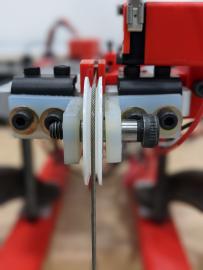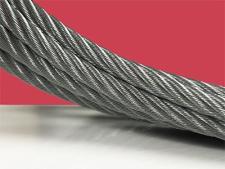Mechanical cables (or wire rope) for surgical robotics, medical devices, aerospace and other industries are a specialty at Carl Stahl Sava Industries. In the manufacture of mechanical cable, no matter the material used to produce it - tungsten, stainless steel, titanium, or others - the cable must undergo rigorous lifecycle testing to ensure it is suited to the application for which is it designed.
What Is Life Cycle Testing?
Mechanical cables, designed to either, or even both, support other components or actuate motion, must be tested to evaluate their strength, flexibility and elasticity, among other life cycle characteristics. Life cycle testing represents a family of tests applied to mechanical cables that are designed to prove (or disprove) the longevity characterics of the wire rope. After all, a mechanical engineer must ensure the cable will support the application for the entire duration of its planned use.
Among the critical tests that examine life cycle is yield testing. Yield testing is normally used to measure the maximum amount of force required to break the cable subject. This test measures the tensile strength of the cable by imposing on it the absolute maximum degree to which the tested cable can tolerate force. The yield testing engineer quite literally places demands on the cable that far exceed the rigors of the live environment to verify its factor of safety.
While force metrics studied during yield testing are important, knowing how each type of cable will perform, in a specific use, is even more critical.
No two mechanical cable assemblies are created equal. For instance, a tungsten cable assembly, for a surgical robot, must achieve an almost impossibly small profile, while supporting thousands of cycles, and reside within super-small spaces. Conversely, a stainless steel cable assembly, used to power a solar sail in an asteroid-chasing satellite, may only need to survive a single deployment at a high load. In other words, the use case is critical to proving out the cable’s life cycle.
Life cycle testing is the analysis of the amount of times a cable can traverse an application environment before it fails, which typically involves the cable breaking and/or stretching beyond its usable length. At its most basic level, life cycle testing is used to determine how long and well mechanical cables perform by subjecting them to specific stresses that mimic their ultimate environment. Areas of analysis include tension, load, temperature exposure, vibration and pressure.
Recreating the real-life environment, albeit in a lab, the cable will have a load limit, which it can safely bear (per yield testing). However, that load will certainly vary when the same cable makes contact with mating and other components.
Why Is Life Cycle Testing Important?
Engineers designing complex motion control systems, surgical equipment, vehicles or industrial instruments cannot afford to use cables that will fail at critical moments. After all, in many cases, the innovations mechanical engineers produce protect or improve quality of life for humans.
The cable just cannot break - period.
Evaluating mechanical cable with life cycle testing is crucial to ensuring that the cable will perform as well as, or even better, than required in the field.
How Sava Extends Mechanical Cable Life Cycles
Sava’s testing engineers go to great lengths to prove, or disprove, design concepts. So, when Sava produced its mechanical cable, it does so with an eye on satisfying the customer’s design requirements, but also one focused on the design's validity itself. While the customer may not be calling on Sava to specifically test the cable assembly’s design concept, life cycle testing exists solely to test this very thing: the potential for the mechanical cable to function optimally in the field.
For instance, Sava’s life cycle experts will quite literally recreate the actual real-life scenario the cable is meant to reside within. Though in a lab, the engineer’s testing will yield true-to-life analysis, saving the customer time, money and other resources by proving - or disproving - concepts during lifecycle testing. Had Sava’s lifecycle experts simply tested the mechanical cable alone, purely as an exercise in proving yield or breaking strength, the engineer would not be able to verify its efficacy in the actual life application.

Sava’s tungsten and stainless steel cables are commonly used in robotic surgery, laparoscopic surgical instruments, air and spacecraft, as well as a host of military-defense and industrial applications. Each of these industries in particular, possess extraordinarily high regulatory standards in the areas of safety, accuracy and reliability. Thus, life cycle testing also serves to satisfies the regulatory obligations of the cable assembly, as part of the overall mechanical engineer’s design expectations. So, especially where governing bodies monitor safety and quality, this mission-critical testing operation pleases regulators and engineers alike.
No matter the intended use of Sava’s mechanical cables, our engineers take any standards, official or unofficial, seriously.
At Sava, we are industry leaders with decades of experience lifecycle testing mechanical cable. Contact us today to learn more about our testing capabilities and commitment to customer satisfaction.






